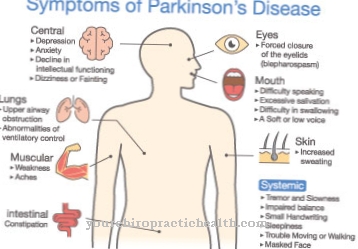Of the Panhypopituitarism is also as Simmonds disease or Simmond's syndrome known. With the disease, too little or no hormones are produced in the anterior pituitary gland.
What is panhypopituitarism?

© Vanessa - stock.adobe.com
Of the Panhypopituitarism is a disease of the anterior pituitary gland. The anterior pituitary gland represents the largest part of the pituitary gland.
It produces the hormones ACTH (adrenocorticotropic hormone), TSH (thyroid stimulating hormone), MSH (melanocyte stimulating hormone), FSH (follicle stimulating hormone), LH (luteinizing hormone), prolactin and somatotropin.
All of these hormones are too few or nonexistent in panhypopituitarism. It is therefore a generalized insufficiency of the anterior pituitary gland. Panhypopituitarism can occur acutely or take a chronic course.
causes
The main cause of panhypopituitarism is a tumor of the pituitary gland. The disease takes a subacute or chronic course here. Autoimmune processes can also impair the function of the pituitary gland. Panhypopituitarism is rarely the result of Sheehan's syndrome. In Sheehan's syndrome, the anterior pituitary gland becomes dysfunctional after birth due to a lack of blood supply in the mother.
Acute insufficiency of the anterior pituitary gland is also triggered by trauma. The entire pituitary stalk is rarely torn off in an accident. Impairment of the pituitary gland from an accident is quite common, however. Studies from the USA show that almost half of all patients with moderate head trauma have impaired pituitary function.
Symptoms, ailments & signs
Only when 80 percent of the pituitary has been destroyed do the first clinical symptoms appear. These are explained by the hormone deficiency. As a result of the TSH deficiency, an underactive thyroid (hypothyroidism) develops. TSH causes the thyroid to produce the thyroid hormones T3 and T4. With a deficiency of T3 and T4, the affected patients suffer from decreased performance, listlessness, weakness, tiredness, constipation, hair loss and depression.
The ACTH hormone works on the adrenal cortex. When stimulated by ACTH, the adrenal cortex produces glucocorticoids, mineralocorticoids, and steroids. If there is a lack of ACTH, too little cortisol is produced. The main symptom of this secondary adrenal insufficiency is weakness. People also lose weight, vomit frequently, and have low blood pressure.
Hyperpigmentation of the skin is also typical. However, if there is also a lack of MSH, the hyperpigmentation may be absent. Patients who do not produce enough melanocyte stimulating hormone look very pale. The lack of follicle stimulating hormone and luteinizing hormone leads to hypofunction of the gonads.
In women, this manifests itself in the absence of menstrual bleeding. The affected women are temporarily infertile. After pregnancy, panhypopituitarism manifests itself with a lack of prolactin through an agalactic acid. The medical term agalactia describes the lack of milk production during the breastfeeding phase. The agalactia occurs mostly in connection with the Sheehan syndrome.
In panhypopituitarism, too little or no growth hormones are produced. This leads to short stature in childhood. In adulthood, the deficiency manifests itself in the form of trunk obesity. In trunk obesity, there is a tendency towards increased fat storage on the trunk. Coronary heart disease (CHD) can also be the result of the lack of growth hormones.
The 7 A's serve as a memory aid for the symptoms of panhypopituitarism: No eyebrows, no armpit hair, agalactia and amenorrhea, apathy and adynamia and alabaster-colored pallor Typical symptoms are also low blood pressure and low osmolality in the urine.
Diagnosis & course of disease
The clinical picture already provides initial indications of the disease. Previous events such as trauma or childbirth can substantiate the suspicion. After a detailed anamnesis, a basic hormone diagnosis or an endocrinological functional diagnosis is usually carried out on the patient. The individual pituitary sub-functions are tested.
Low pituitary hormones such as ACTH or FSH are groundbreaking in laboratory diagnostics. The target hormones of these regulating hormones are also decreased. So there are not enough thyroid or adrenal cortex hormones in the blood. A stimulation test can be performed to determine whether the disorder originates from the anterior pituitary itself or from the parent hypothalamus. The hormone secretion of the pituitary gland is stimulated at various levels.
The most important test is the insulin hypoglycemia test. This test involves injecting insulin into the patient. This leads to a significant decrease in blood sugar. Normally ACTH, cortisol and somatotropin would be released due to a massive stress reaction. If the increase does not occur, there is pituitary or hypothalamic damage. Further releasing hormone tests can be performed to rule out the hypothalamus as the cause.
These tests include the CRH test, the GHRH test, and the TRH test. Since the cause of pituitary insufficiency is usually a tumor, imaging diagnostics must always be carried out if panhypopituitarism is suspected. Magnetic resonance imaging is therefore usually performed. Since pituitary tumors, due to their spatial location, also endanger the optic nerves, an ophthalmological diagnosis should also be carried out.
Complications
In most cases, panhypopituitarism has a hormone deficit, which can lead to various complications and complaints. However, the further course depends heavily on this deficit, so that as a rule no general prediction can be made about it. However, those affected with panhypopituitarism still suffer from a malfunction of the thyroid gland.
This leads to tiredness and general exhaustion of the person concerned. Patients also often suffer from hair loss, depression and constipation. The quality of life of the person affected is considerably reduced due to the illness. If this complaint is not treated, it can also lead to adrenal insufficiency, which can have a negative impact on the life expectancy of the person affected.
Weight loss or low blood pressure can also occur due to panhypopituitarism and continue to restrict the person's everyday life. If the disease occurs in childhood, it can lead to short stature or various heart diseases. As a rule, the treatment of the disease is always based on the cause. In the case of a tumor, it must be removed. No general course can be predicted because the tumor may have spread to other regions of the body.
When should you go to the doctor?
Changes in the hormonal balance indicate a health disorder. If they are constant or if they increase in intensity, a doctor is needed. In the case of complaints such as hair loss, changes in the appearance of the skin and disorders of the digestive tract, a doctor's visit is necessary. If sexually mature women experience irregularities or a lack of menstrual bleeding, we recommend clarifying the symptoms. If the desire to have children is unfulfilled despite all efforts, a check-up is advisable to clarify the fertility status.
Decreased libido or sexual dysfunction are signs of an abnormality in the body that should be treated. Behavioral problems, mood swings and changes in personality are warning signs that should be followed up. If there is a withdrawal behavior or a reduced participation in social life, a check-up visit with a doctor or therapist is advisable. Changes in weight, repeated vomiting, and nausea are also alarming signals.
Disorders of the growth process in children and adolescents, short stature, a pale appearance and irregularities in the heart rhythm should be presented to a doctor. Sluggishness, apathy, easy fatigue and an increased need for sleep are all signs of impaired health and should be examined by a doctor. Fat deposits, swellings or a general malaise as well as a feeling of illness should be assessed by a doctor. Consultation with a doctor is recommended for people with decreased well-being.
Therapy & Treatment
The therapy of panhypopituitarism depends on the cause. If the disease is based on a tumor, the therapeutic approach depends on the size of the tumor, the type of tumor and the threat of damage from the mass. As a rule, there is a combination of surgical and medicinal measures.
Radiation therapy is also used. In this way, the restricted pituitary function can often be restored. If restoration is not possible, the missing hormones must be substituted.
Outlook & forecast
The sudden underactive pituitary gland can lead to various functional disorders and degrees of severity. Depending on the cause and effect, it is a severe to very severe acute illness. The outlook for people suffering from hypophyseal hypofunction (panhypopituitarism) can therefore only be judged by who caused the hypofunction. Comprehensive diagnostics are essential.
Some of the causes of underactive pituitary gland can now be treated fairly well. In this case the prognosis is much more positive. The quality of life of those affected can often be improved by administering missing hormones. Your chances of survival increase to a normal life expectancy. If the missing hormones cannot be administered, the survival expectancy with this disorder can still be ten to fifteen years.
The situation is different with patients who fall into a pituitary coma. The reason for this can be severe stress. Pituitary coma can be triggered by untreated hypothyroidism or pituitary gland hypofunction, or a stroke. It is a life-threatening situation. This requires immediate emergency action. The prognosis depends on how quickly these measures are taken. In addition, the severity of the resulting sequelae or the age of the person affected are also a criterion. Without the immediate administration of glucocorticoids and thyroid hormones, many coma patients die.
prevention
Panhypopituitarism cannot be prevented.
Aftercare
In most cases, those affected have only limited direct follow-up measures available for panhypopituitarism. For this reason, early diagnosis of this disease is very important so that there are no other complications or complaints. Therefore, those affected should ideally consult a doctor at the first signs and symptoms of panhypopituitarism.
As a rule, self-healing cannot occur. Those affected depend on the intake of various medications that can alleviate these symptoms. The person affected should pay attention to the prescribed dosage so that the symptoms can be alleviated. Regular checkups and examinations by a doctor are also very important so that there are no other complications or complaints that could reduce the quality of life of the person concerned.
It is not uncommon for those affected to have to rely on the help and support of friends and family due to panhypopituitarism, which can prevent the development of depression and other psychological complaints. The further course of panhypopituitarism depends heavily on the time of diagnosis, so that, as a rule, no general prediction is possible.
You can do that yourself
Panhypopituitarism often triggers a hormone deficit, so the symptoms should be monitored closely. To avoid or alleviate complications, those affected should contact a doctor early on. Signs like tiredness and fatigue can be a sign of worsening. Other complaints such as depression, hair loss and constipation reduce the quality of life. For this reason, it is essential to get medical treatment for the disease.
By regularly taking the prescribed medication, the thyroid dysfunction associated with the disease can be combated. If there are particular behavioral problems or mood swings, patients should follow these warnings and be honest with their doctor. In this context, social behavior plays a role that should not be underestimated.
If necessary, treatment with a psychotherapist is advisable. When the psychological moods are balanced, it is much easier for the patient to cope better with the physical complaints and the special symptoms. This type of therapy can therefore be very important for children and adolescents. In the event of repeated nausea, vomiting and severe changes in body weight, patients should not hesitate long, but rather make an appointment with a doctor soon. By acting quickly in the event of such alarm signals, those affected get their complaints under control.


.jpg)

.jpg)

.jpg)




















